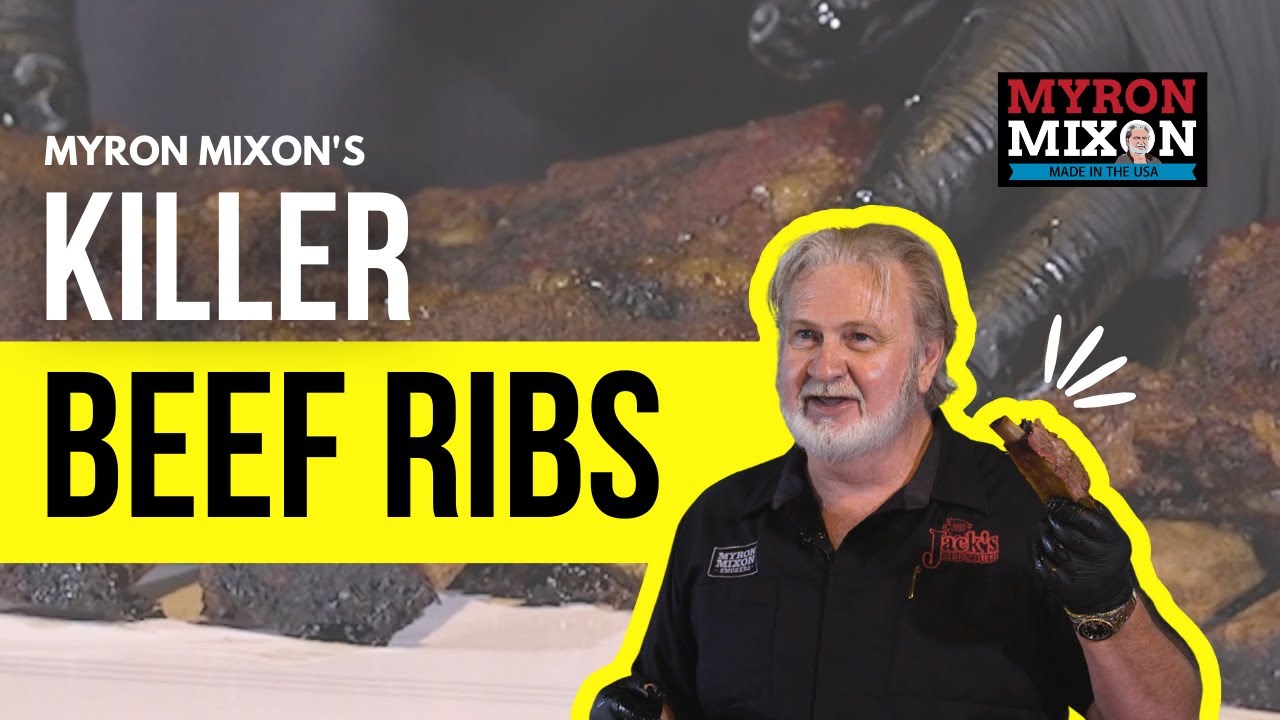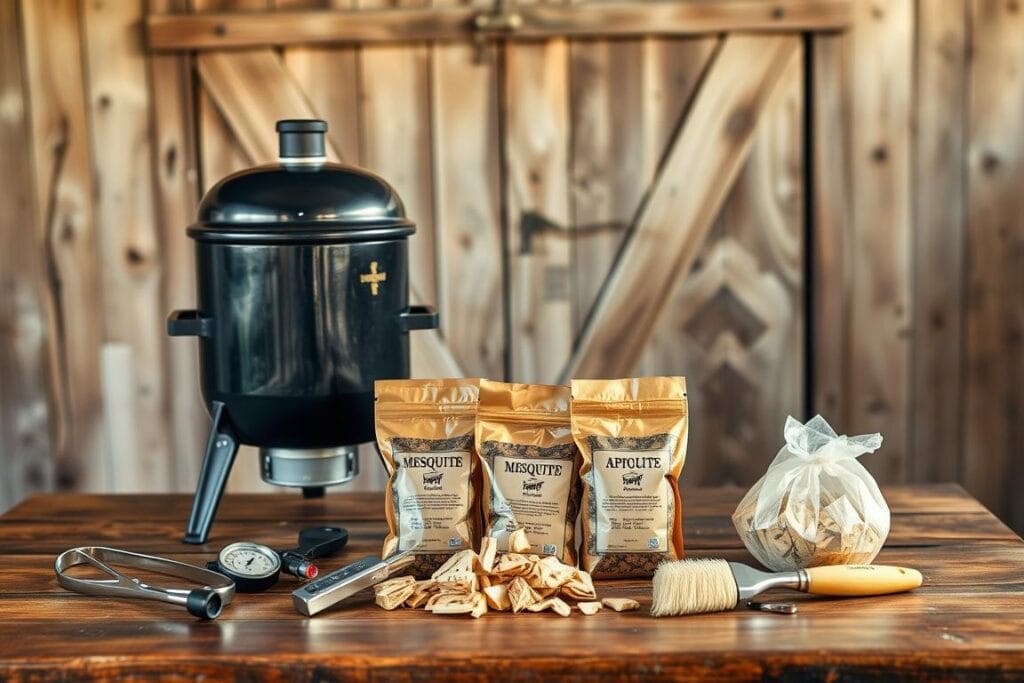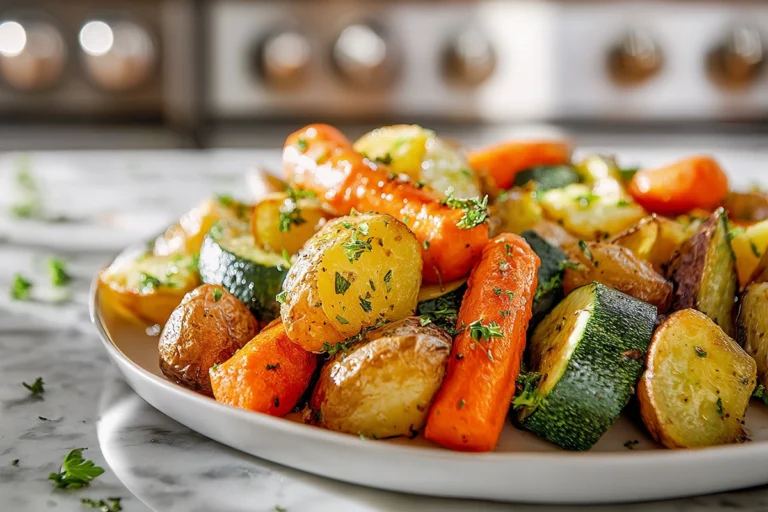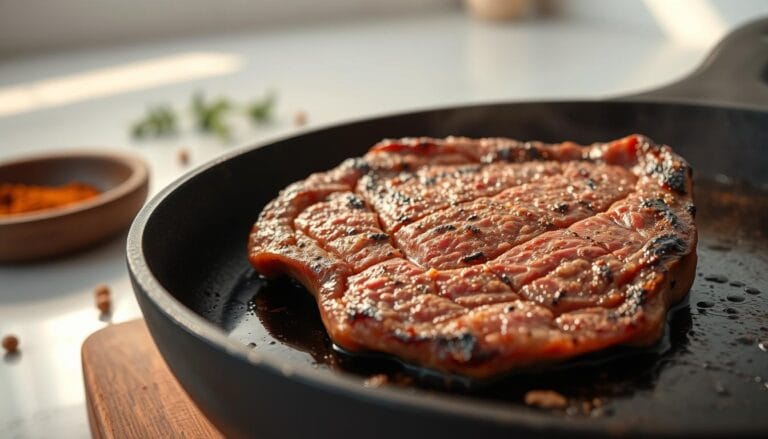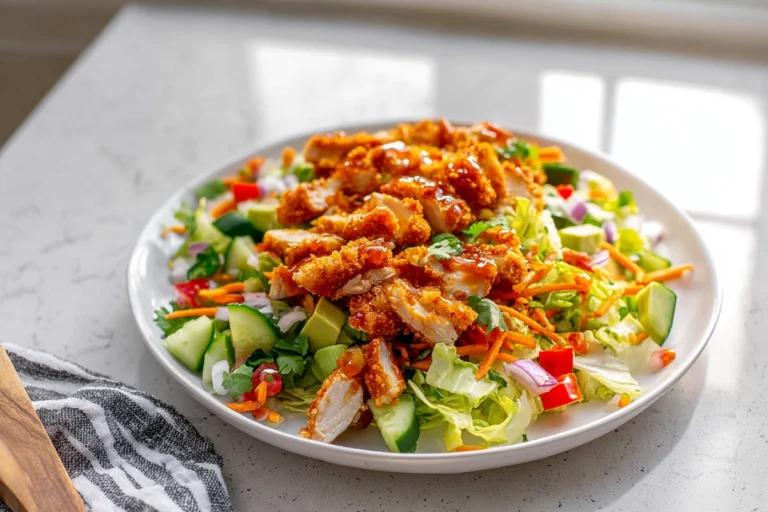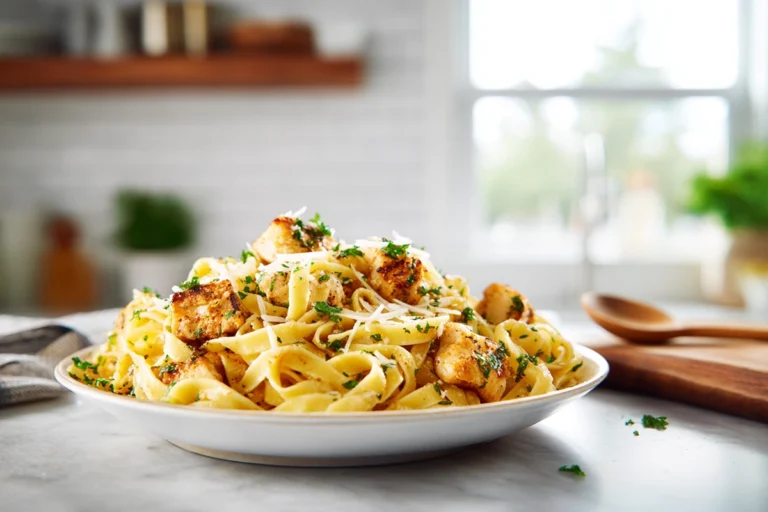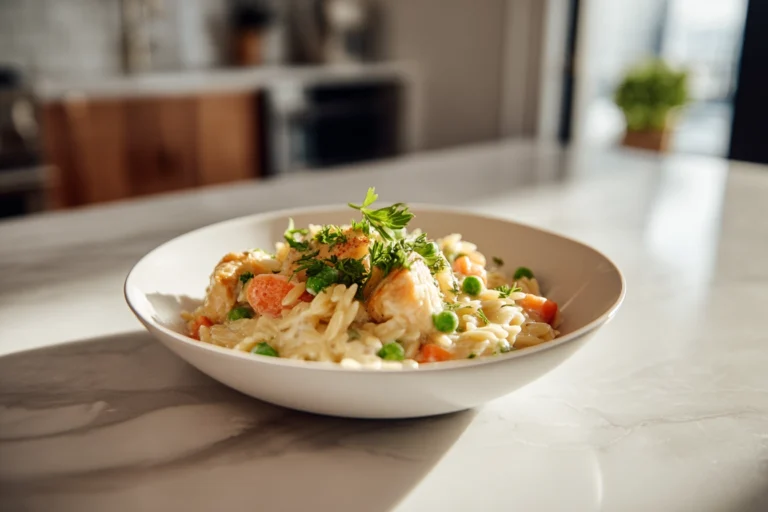How to Make Perfect Smoked Beef Short Ribs – Tender, Juicy, and Bold
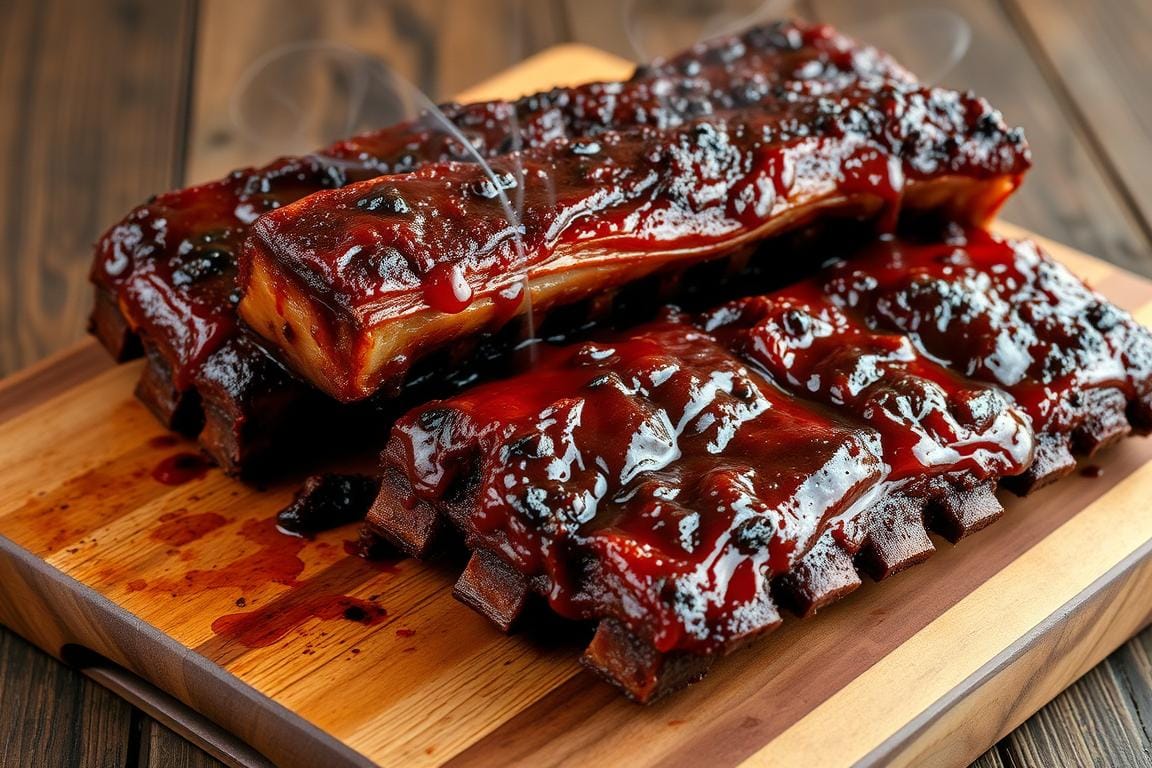
Smoked beef short ribs recipe lovers, this one’s for you. Imagine biting into tender, juicy short ribs packed with smoky flavor. They’re the star of any BBQ spread. With low and slow cooking and pitmaster techniques, this recipe brings out a deep, rich taste every time, whether you’re a seasoned griller or a backyard beginner.
You don’t have to be an expert to make amazing short ribs. With some guidance, you can wow your friends and family. This article will guide you through a simple yet delicious recipe for smoked beef short ribs. You’ll learn tips and tricks to make your next BBQ unforgettable.
Key Takeaways
- Mastering the art of slow cooking is crucial for tender short ribs.
- Understanding pitmaster techniques can elevate your BBQ game.
- A simple yet flavorful recipe can make your smoked beef short ribs stand out.
- The right preparation and patience are key to achieving fall-off-the-bone tenderness.
- Experimenting with different flavors can help you find your signature BBQ style.
Understanding Beef Short Ribs: A Pitmaster’s Guide
To master smoked beef short ribs, you must first grasp the basics. Beef short ribs are a rewarding cut to cook. They become tender and flavorful when slow-cooked. This guide will help you understand the different types of short ribs, how to choose the best cut, and what to look for in quality.
Different Types of Short Ribs
Beef short ribs come in two main types: flanken-style and English-style. Flanken-style ribs are cut across the bone, making them thin and with lots of surface area. English-style ribs are cut parallel to the bone, offering larger, meatier portions.
For slow-cooked ribs, English-style is often the better choice. It keeps more moisture and tenderness during cooking.
Choosing the Best Cut for Smoking
When picking beef short ribs for smoking, aim for a good balance of meat and fat. The fat is key as it melts during slow cooking, making the ribs tender and flavorful. English-style short ribs are best for smoking because they have more meat and better texture after cooking.
Quality Indicators to Look For
When buying beef short ribs, look for certain qualities. First, check for marbling of fat; it boosts flavor and tenderness. Second, the meat should be a rich red color, showing it’s fresh. Lastly, avoid ribs with too much trimming or exposed bone.
| Quality Indicator | Description | Importance |
|---|---|---|
| Marbling of Fat | Even distribution of fat within the meat | High |
| Meat Color | Rich red color indicating freshness | High |
| Trimming and Bone Exposure | Minimal trimming and bone exposure | Medium |
By knowing the different types of beef short ribs, choosing the right cut, and looking for quality indicators, you’ll make delicious, slow-cooked ribs. These will surely impress any crowd.
Essential Equipment for Smoking Short Ribs
To smoke short ribs perfectly, you need the right gear. A good smoker is key to tender ribs. Look for one that can keep a steady temperature between 225-250 degrees Fahrenheit.
Choosing the right wood is also important. Hickory and oak are great for beef, adding a smoky taste. Try different woods to find the best flavor for your smoker recipes.
You’ll also need a meat thermometer and a rib rack. These tools help with cooking and organizing your ribs. A tasty rib rub adds extra flavor to your ribs.
Having a clean, organized workspace is crucial. It keeps you focused and ensures your ribs are perfect. With the right tools and practice, you’ll make delicious, tender smoked ribs that everyone will love.
Remember to use a water pan for humidity and keep ribs away from direct heat. These tips, along with the right equipment, will help you make amazing smoker recipes.
The Perfect Smoked Beef Short Ribs Recipe
Now, let’s dive into the perfect smoked beef short ribs recipe. To get tender and flavorful ribs, you need quality ingredients, careful preparation, and patience.
A great dry rub is key to a good recipe. A balanced rub can make the ribs taste amazing. Pitmaster Steven Raichlen says, “A good rub should have sweet, savory, and spicy flavors.”
‘A good rub is like a good marinade, it should enhance the natural flavors of the meat without overpowering it.’
Ingredient List
Here’s what you need for a delicious smoked beef short ribs recipe:
| Ingredient | Quantity |
|---|---|
| Beef short ribs | 4 pounds |
| Hot sauce | 1/4 cup |
| Dad’s All Purpose rub | 1/4 cup |
| Steak rub | 2 tablespoons |
| Brown sugar | 1 tablespoon |
| Smoked paprika | 1 tablespoon |
Preparation Steps
To prepare your smoked beef short ribs, follow these steps:
- Preheat your smoker to 250°F.
- In a small bowl, mix together the hot sauce, Dad’s All Purpose rub, steak rub, brown sugar, and smoked paprika to create the dry rub.
- Apply the dry rub evenly to the beef short ribs, making sure to coat all surfaces.
- Place the ribs in the smoker, bone side down, and close the lid.
- Smoke the ribs for 4-5 hours, or until they reach an internal temperature of 203°F.

Creating Your Signature Rub
You can also make your unique dry rub. Try adding garlic powder, onion powder, or cayenne pepper. The goal is to find a balance that enhances the beef’s natural flavors.
By following these steps and using quality ingredients, you’ll make delicious smoked beef short ribs. This recipe is perfect for both seasoned pitmasters and beginners.
Preparing Your Smoker for Success
A well-prepared smoker is key to tender and flavorful short ribs. Focus on temperature control, wood selection, and heat zone setup for the best results.
Temperature Control Basics
Temperature control is crucial when smoking short ribs. You must keep the temperature steady for even cooking. Most smokers have a temperature range. It’s important to know how to use it well.
Tips for Temperature Control:
- Use a thermometer to monitor the temperature accurately.
- Adjust the vents to control airflow and temperature.
- Keep the smoker lid closed to maintain consistent heat.
Wood Selection Guide
The wood you choose greatly affects the flavor of your short ribs. Different woods give different flavors. It’s important to pick the right one for your recipes.
| Wood Type | Flavor Profile |
|---|---|
| Hickory | Strong, smoky, and savory |
| Oak | Mild, smoky, and slightly sweet |
| Cherry | Fruitier, milder, and slightly sweet |
Try different wood types to find the best flavor for your ribs.
Setting Up Heat Zones
Setting up heat zones in your smoker gives you more control. This way, you can cook your short ribs perfectly.
Steps to Set Up Heat Zones:
- Identify the heat source in your smoker.
- Arrange your coals or heat source to create different zones.
- Use a thermometer to monitor the temperature in each zone.
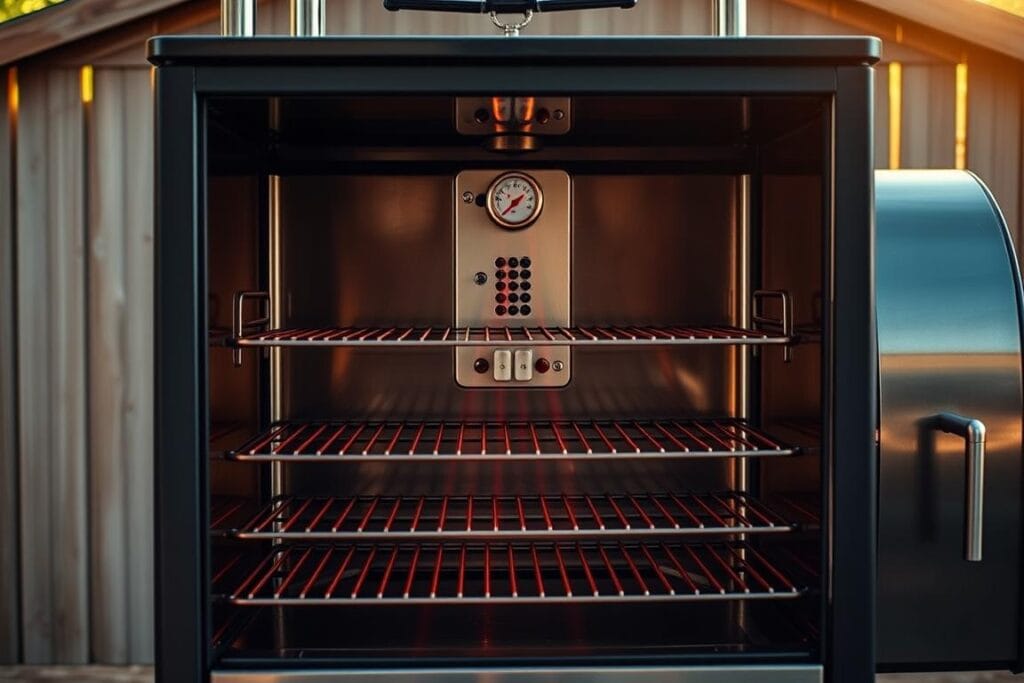
By following these steps and tips, you’ll get tender smoked ribs that will wow everyone.
Mastering the Smoking Process
To get tender, fall-off-the-bone smoked beef short ribs, you need to master the smoking process. This means controlling temperature, managing wood, and keeping the smoke flow steady. As a famous pitmaster says,
“The art of smoking is not just about throwing some wood on the fire and waiting; it’s about understanding the nuances of temperature, smoke, and patience.”
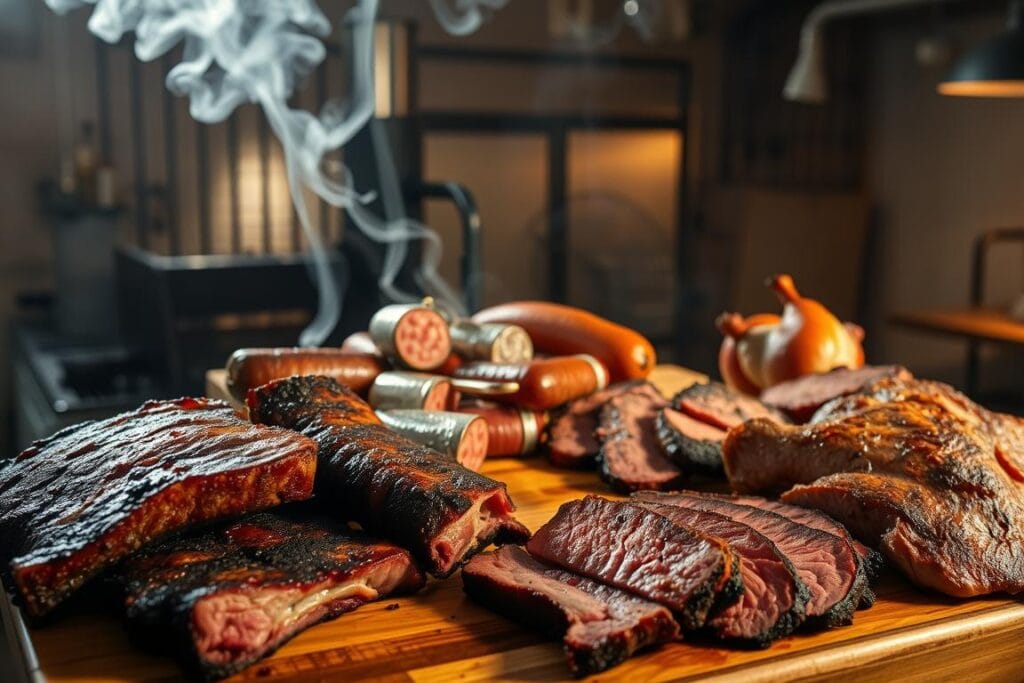
When smoking short ribs, keeping the temperature steady is key. The third source suggests smoking them at 250 degrees Fahrenheit for 5-7 hours. This slow cooking makes the meat tender and full of flavor. You must watch your smoker’s temperature and adjust it when needed. Keeping the temperature right is crucial for tender results.
Wood management is also important. The wood you use can change the flavor of your short ribs. Hardwoods like oak or hickory add a smoky taste, while fruitwoods like apple or cherry give a sweeter flavor. Trying different woods can help you find the perfect taste for your recipes.
Keeping the smoke flow steady is also vital. This means your smoker should smoke consistently throughout cooking. A steady smoke flow adds deep flavor to the meat. To keep the smoke flow steady, you might need to adjust your smoker’s vents or add more wood.
Problems like temperature changes, uneven smoke, and overcooking can happen. To fix these, you need to watch closely and adjust as needed. For example, if the temperature drops, you can adjust the vents or add more fuel.
By mastering the smoking process, you can make professional-grade slow-cooked ribs. With practice and patience, you’ll get tender, flavorful short ribs that impress everyone. As you get better, grilling tips and techniques will become second nature. This lets you focus on making delicious, memorable meals.
Understanding the Stall and How to Handle It
When smoking beef short ribs, a common issue pitmasters face is the stall. This happens when the meat’s internal temperature seems to stop rising, even with a steady smoker temperature. Knowing how to handle the stall is key to getting tender, fall-off-the-bone ribs.
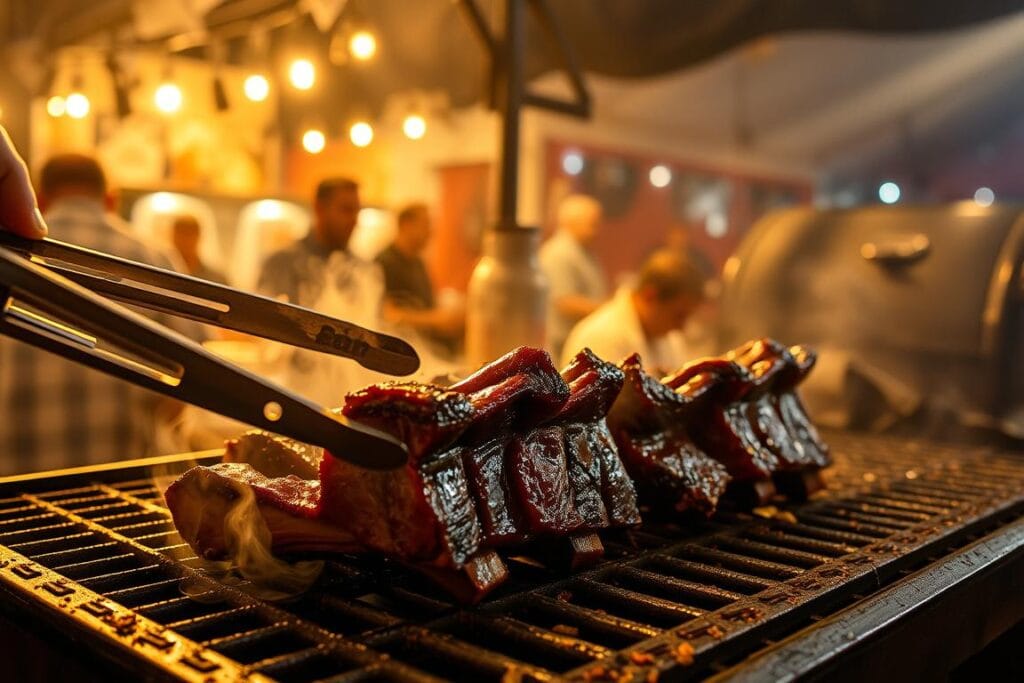
The stall, or “stalling phase,” usually starts when the meat hits 150°F to 170°F (65°C to 77°C). During this time, the meat’s internal temperature can stay the same for hours. It’s important to remember that the stall is a normal part of smoking and shouldn’t worry you.
Causes of the Stall
Several things can cause the stall. One main reason is the evaporation of moisture from the meat’s surface. This cools it down and slows the temperature rise. Another reason is the denaturation of proteins and the breakdown of connective tissues, which can temporarily stop the temperature from going up.
Techniques to Push Through the Stall
To get past the stall, pitmasters use a few tricks. One good method is to wrap the short ribs in foil or butcher paper. This keeps moisture in and helps tenderize the meat. This technique, known as the “Texas Crutch,” creates a humid environment that helps the meat cook faster.
Another way is to adjust the smoker’s temperature. Raising the temperature can speed up cooking. But, it’s important not to overcook the meat. Keeping a close eye on the internal temperature is crucial to avoid tough or dry ribs.
Choosing the right wood and keeping the smoker temperature steady also helps. A well-maintained smoker with no big temperature swings can greatly improve your smoked beef short ribs.
Achieving the Perfect Bark
The bark on your ribs is more than looks; it’s a flavor powerhouse. A great bark makes your ribs unforgettable. To get this, you need the right techniques and ingredients.
Choosing the best rib rubs is key. Rubs with smoked paprika, garlic powder, and onion powder boost flavor and texture. These add depth and help create a rich, caramelized crust.
The type of wood used in smoker recipes affects the bark. Different woods give different flavors. Hickory and mesquite are great for strong, smoky tastes that match beef short ribs.
For tender smoked ribs with great bark, manage the smoking well. Keep the temperature right, ensure moisture, and don’t rush. Patience is crucial for slow cooking, which helps the bark form beautifully.
- Use a dry rub with smoked paprika, garlic powder, and onion powder.
- Choose the right type of wood for smoking, such as hickory or mesquite.
- Maintain the right temperature and moisture levels during the smoking process.
By following these tips, you can get the perfect bark on your smoked beef short ribs. This improves both looks and taste, making your smoker recipes shine.
Testing for Doneness: Signs and Techniques
Checking if your smoked short ribs are done is key to their tenderness and taste. Getting them just right can be tricky. But with the right methods, you can always get delicious results.
Temperature Guidelines
Using a meat thermometer is a top way to check doneness. For smoked short ribs, aim for an internal temperature of 205-210 degrees Fahrenheit. This ensures the meat is tender and falls off the bone.
Temperature Guidelines for Smoked Short Ribs:
| Meat Type | Internal Temperature (°F) |
|---|---|
| Beef Short Ribs | 205-210 |
The Probe Test
The probe test is another good way to check if the ribs are done. Stick a probe or skewer into the meat. If it goes in easily, the ribs are ready. If not, they need more time.
Tip: Always probe the thickest part of the ribs for the best reading.
Visual Indicators
Visual signs can also tell you if the ribs are done. Look for a dark, caramelized bark. The meat should be pulling away from the bone, and the bones should show. The ribs should also feel tender and a bit jiggly.
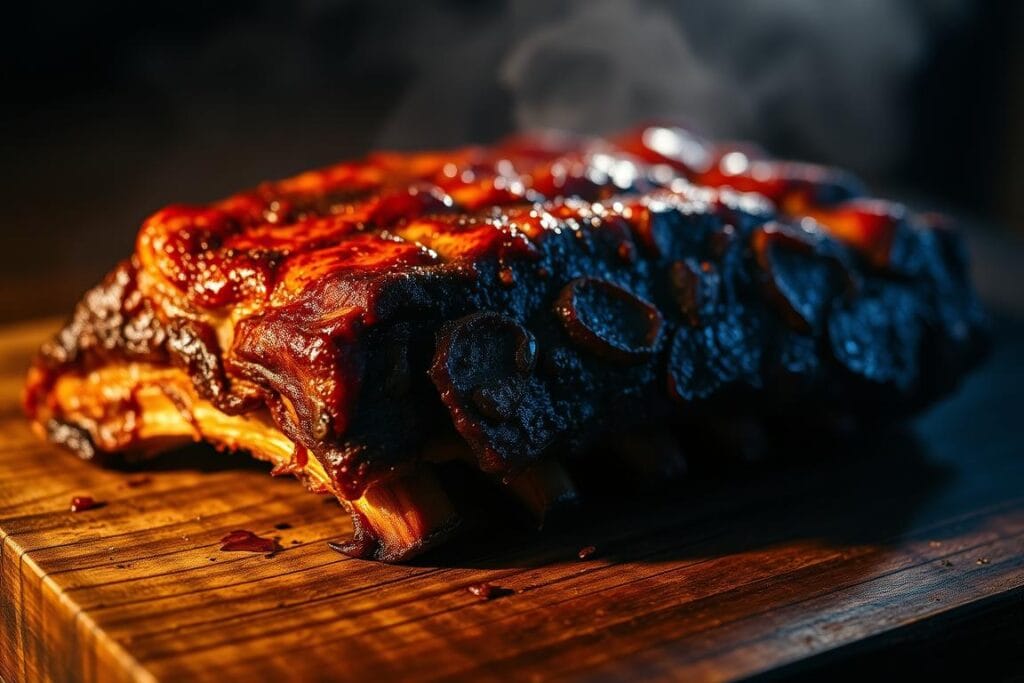
By using temperature checks, the probe test, and looking at visual signs, you can make sure your smoked short ribs are perfect every time.
Resting and Slicing Your Smoked Short Ribs
A pitmaster’s secret to tender smoked beef short ribs recipe is resting and slicing. After cooking, let the ribs rest before serving. This step makes the meat tender and flavorful.
Resting your smoked bbq ribs is key. It lets the connective tissues relax, making the ribs more enjoyable. The first source suggests resting for 30-45 minutes before slicing. This patience ensures tender and flavorful ribs.
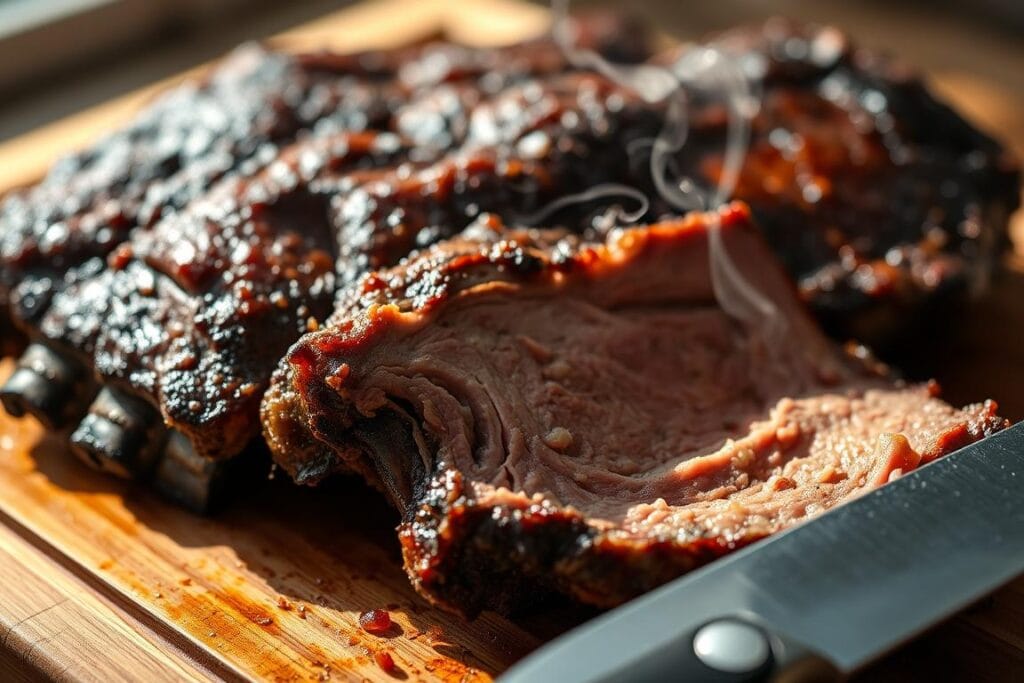
When slicing, the technique is as important as resting. To slice, cut against the grain. This makes the meat tender and easy to chew.
Here are some pitmaster techniques for slicing:
- Use a sharp knife for clean cuts and to prevent tearing.
- Slice when the ribs are warm for easier, thinner cuts.
- Slice into portions for easier serving.
By focusing on resting and slicing, you can improve your smoked BBQ ribs. Patience and detail are key for tender, fall-off-the-bone ribs.
In conclusion, mastering resting and slicing is essential for any pitmaster. By following these techniques, you’ll create a dish that impresses.
Serving Suggestions and Pairings
Take your barbecue to the next level by pairing tender smoked ribs with the right sides and sauces. The right pairings make a meal memorable. Mastering smoked beef short ribs means finding the perfect complements.
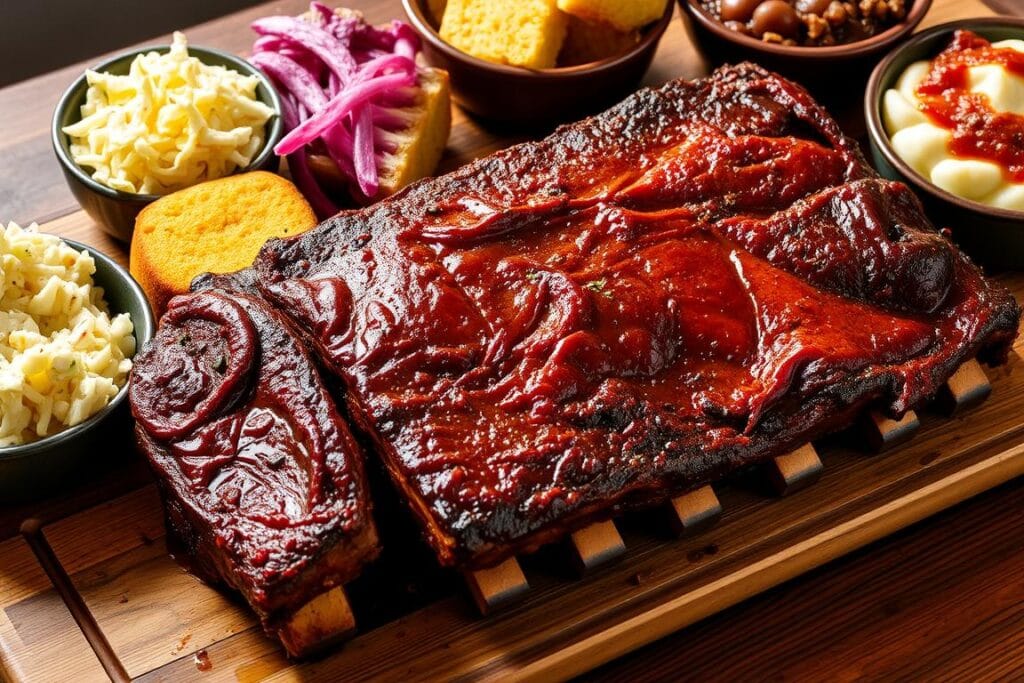
Side Dish Recommendations
Choosing the right sides can boost your smoked short ribs’ flavors. Classic choices like coleslaw, baked beans, and cornbread are always a hit. For something new, try creamy mashed potatoes or a fresh grilled vegetable salad.
Roasted veggies like asparagus or Brussels sprouts add a nice crunch. The goal is to balance the ribs’ richness with refreshing sides.
Sauce Pairing Guide
The right BBQ sauce can make your smoked short ribs even better. You can choose from sweet, tangy, or spicy sauces. Some like vinegar-based, while others prefer tomato-based.
Offering different sauces lets guests pick their favorite. A signature BBQ sauce made with special spices can be a unique touch.
Plating Tips
How you present smoked short ribs matters. A good presentation makes the meal more enjoyable. Start by slicing the ribs against the grain for tenderness.
Place the ribs on a platter or individual plates. Add fresh herbs like parsley or thyme. Drizzle with BBQ sauce and serve with your chosen sides. This makes for a beautiful and appetizing dish that will wow your guests.
Making Perfect Smoked Beef Short Ribs Every Time
With the right techniques and equipment, you can make tender, fall-off-the-bone smoked beef short ribs every time. The key is to understand the nuances of slow-cooked ribs. Also, apply grilling tips that enhance the flavor and texture.
Smoked meat recipes like the one outlined in this article rely on patience and attention to detail. By following the steps outlined, you’ll be well on your way to creating mouth-watering short ribs. These will impress your family and friends.
To ensure success, focus on temperature control, wood selection, and resting your meat. These elements, combined with a signature rub and careful monitoring, will result in slow-cooked ribs that are both tender and flavorful.
Now that you’ve learned the secrets to perfect smoked beef short ribs, it’s time to put them into practice. Experiment with different flavors and techniques to make the recipe your own. Enjoy the delicious results.
FAQ
What type of wood is best for smoking beef short ribs?
Hardwoods like post oak, hickory, or mesquite are great for smoking beef short ribs. They add a strong, smoky flavor. This flavor complements the rich taste of beef, making the ribs even more delicious.
How long does it take to smoke beef short ribs?
Smoking beef short ribs takes about 5 to 6 hours. The exact time depends on the ribs’ size and the temperature. Keeping the temperature steady and checking the ribs’ tenderness is key.
What is the ideal temperature for smoking beef short ribs?
The best temperature for smoking beef short ribs is between 225°F to 250°F. This low temperature ensures the ribs are tender and fall-off-the-bone.
How do I achieve tender, fall-off-the-bone short ribs?
For tender ribs, cook them low and slow. Use a low temperature and keep them moist. Wrapping the ribs in foil during cooking helps keep them moist.
What’s the best way to slice smoked short ribs?
Slice smoked short ribs against the grain for tender meat. Letting the ribs rest before slicing helps the juices spread, making the meat more flavorful.
Can I use a gas smoker for smoking beef short ribs?
Yes, you can smoke beef short ribs in a gas smoker. Make sure it can keep a low temperature. Also, use a wood chip or chunk tray to add smoky flavor.
How do I prevent the stall when smoking beef short ribs?
The stall is when the meat’s temperature seems to stop rising. To avoid it, wrap the ribs in foil, slightly raise the temperature, or use a water pan to keep humidity up.
What’s the best rub for smoked beef short ribs?
A dry rub with spices like paprika, brown sugar, garlic powder, and chili powder is good. You can also try different ingredients to make your own unique rub.
Get inspired with more mouthwatering recipes! Follow me on Facebook, Pinterest, and subscribe to YouTube for new cooking ideas every week.
Print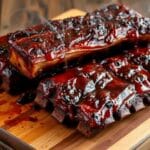
Delicious Smoked Beef Short Ribs: A Must-Try Recipe
- Total Time: 5–6 hours (including resting)
- Yield: Serves 4–6 1x
Description
Smoked Beef Short Ribs are the ultimate BBQ centerpiece—rich, meaty, and fall-off-the-bone tender. This recipe uses a flavorful dry rub and low-and-slow smoking method to achieve a bold bark and succulent interior. Perfect for backyard gatherings, holiday feasts, or serious pitmasters looking to impress, these ribs are loaded with smoky flavor and unforgettable texture.
Ingredients
For the Ribs and Rub:
4 pounds beef short ribs (English-style preferred)
1/4 cup hot sauce
1/4 cup Dad’s All Purpose rub (or any all-purpose BBQ rub)
2 tbsp steak rub
1 tbsp brown sugar
1 tbsp smoked paprika
Optional Custom Rub Additions:
1 tsp garlic powder
1 tsp onion powder
1/2 tsp cayenne pepper
Smoking Tools & Wood:
Smoker (pellet, offset, charcoal, or gas)
Wood chips or chunks (hickory, oak, or mesquite recommended)
Meat thermometer
Water pan (optional but recommended)
Instructions
-
Prep Smoker:
Preheat smoker to 250°F (121°C). Add a water pan for moisture and set up indirect heat zones if needed. -
Prepare the Rub:
In a bowl, mix hot sauce, BBQ rubs, brown sugar, and smoked paprika into a thick paste. -
Season the Ribs:
Pat ribs dry. Coat evenly with the rub on all sides. Let sit at room temp for 30 minutes. -
Smoke the Ribs:
Place ribs bone-side down in smoker. Smoke for 4–5 hours, until internal temperature reaches 203°F (95°C). Use hickory or oak for a bold, smoky flavor. -
Rest the Meat:
Remove ribs and let rest, tented with foil, for 30–45 minutes before slicing. -
Slice & Serve:
Cut against the grain. Serve with BBQ sauce and your favorite sides.
Notes
Stall tip: Wrap in foil at 160–170°F (Texas Crutch) to push through the stall.
Check for doneness: Use the probe test—it should slide in like soft butter.
Optional glaze: Brush ribs with sauce in the last 20 minutes if desired.
Best served with: coleslaw, cornbread, baked beans, mashed potatoes, or grilled vegetables.
- Prep Time: 30 minutes
- Cook Time: 4–5 hours
- Category: Main Course
- Method: Smoked
- Cuisine: American BBQ
What Are Our Readers Saying?
There are no reviews yet. Be the first one to write one.

